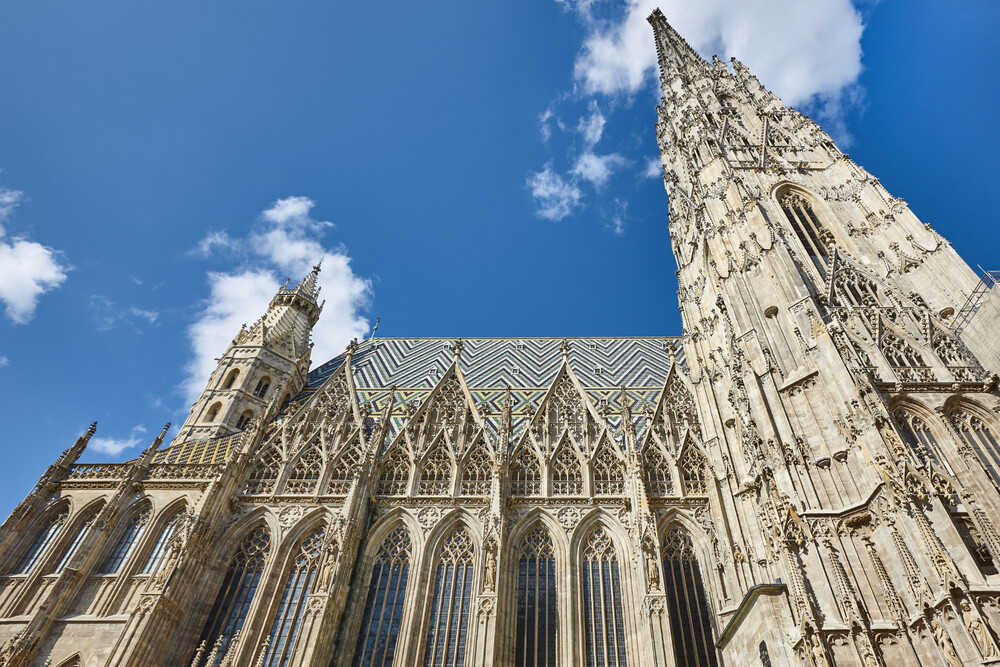The Birth of a Legend: A Journey Through Time at St. Stephen's Cathedral
The history of St. Stephen's Cathedral began in the 12th century, when the foundation stone for the first church was laid in 1137, consecrated ten years later.
It underwent a significant transformation under the rule of Rudolf IV, "the Founder," who initiated the Gothic reconstruction in 1359, giving rise to today's imposing form.
The cathedral has survived much, including a devastating fire in 1945, after which reconstruction followed, symbolizing Austria's resilience and rebirth.
Architectural Gem: Towers, Roof, and Masterful Details
The South Tower, nicknamed "Steffl," is an unmissable landmark, soaring to a height of 136.4 meters (447.5 feet). After climbing 343 steps, you'll be rewarded with a breathtaking view of all of Vienna.
The North Tower, called Adlerturm (Eagle Tower) and standing 68.3 meters (224 feet) tall, houses the famous Pummerin bell, the third-largest free-swinging church bell in Europe.
The unique, colorful roof is adorned with 230,000 tiles, creating the imperial eagle motif and the coats of arms of Vienna and Austria. The oldest parts, the Heidentürme (Pagan Towers) and the Riesentor (Giant's Gate), recall the building's Romanesque origins.
Treasures Within: Altars, Pulpit, and Sacred Art
The cathedral's interior is a true treasure trove. The main Baroque altar by Tobias Pock depicts the stoning of St. Stephen. The Gothic pulpit, known as the Pilgramkanzel, is the work of Anton Pilgram, who also left his self-portrait here, the "Fenstergucker" (window peeper).
Other gems include the Wiener Neustädter Altar (Vienna Neustadt Altar) from 1447 and the imposing tomb of Emperor Frederick III. Part of the cathedral's treasures are displayed in the adjacent Dom Museum Wien.
Into the Viennese Underground: The Mysterious Catacombs of the Cathedral
Beneath St. Stephen's Cathedral lies the mysterious world of the catacombs, an underground burial site accessible only by guided tour. The remains of Habsburgs, including Duke Rudolf IV, "the Founder," rest here, as do thousands of Viennese, often victims of plague epidemics.
A tour of these spaces offers a chilling yet fascinating glimpse into the city's history and its inhabitants, contrasting with the grandeur of the cathedral itself.
Viennese Myths: Legends Whispering in the Cathedral's Shadows
St. Stephen's Cathedral is shrouded in many legends. One of the most famous tells of the "Zahnwehherrgott" (Lord of Toothache), a statue of Christ whose face mockers tied with a cloth, only to suffer severe toothaches themselves.
Another tale is linked to the builder of the North Tower, Hans Puchsbaum, and his alleged pact with the devil, which led to the tower's incompletion. The cathedral's fame is also evidenced by its depiction on the packaging of traditional Viennese Manner wafers.
Plan Your Visit: Practical Tips for Explorers
St. Stephen's Cathedral is generally open for worshippers Monday to Saturday from 6:00 AM to 10:00 PM, and on Sundays and holidays from 7:00 AM to 10:00 PM. Tourist visits to the main nave are possible approximately Mon-Sat 9:00 AM–11:30 AM and 1:00 PM–4:30 PM, Sun/holidays 1:00 PM–4:30 PM.
Don't miss climbing the South Tower, taking the elevator up the North Tower to the Pummerin, or touring the catacombs. Current information on opening hours, prices, and tour types can be found on the official website www.stephanskirche.at.

